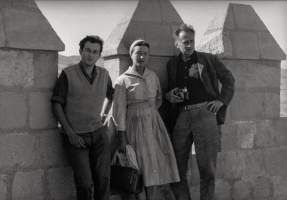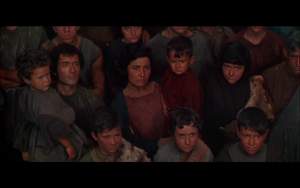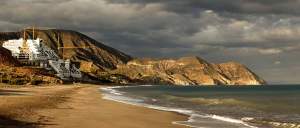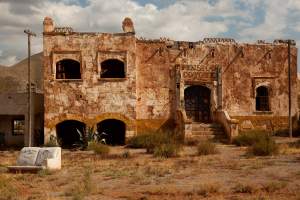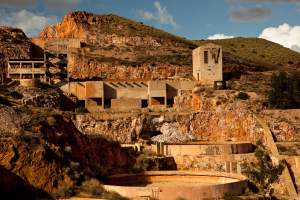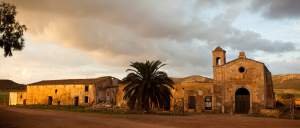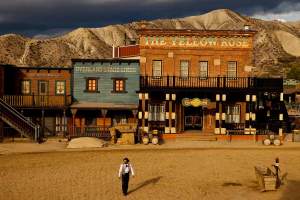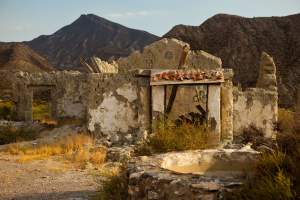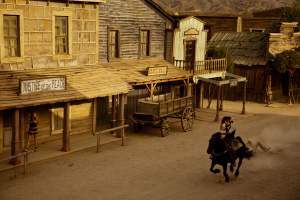Archives
Nelson Algren and Simone De Beauvoir’s Road Trip Through Franco’s Spain
Only a handful of photographs exist of Simone de Beauvoir and Nelson Algren together from a love affair that persisted, mostly across the Atlantic ocean, for over a decade. Possibly the last photograph of them together is from a visit to Spain in May 1960. In the photograph, they stand with Catalan writer Juan Goytisolo to their right along the wall of the Alcazaba, an old Moorish palace, in Almería. A glimpse of the mountainous landscape beyond can be seen over Goytisolo’s shoulder. Beauvoir, in the middle, looks intently into the camera with the air of a school teacher, while […]
Read MoreSpartacus: Between Spain and Hollywood
Spartacus was supposed to be filmed entirely in California. By 1960 there was growing alarm about the impact of “runaway” productions, which sought to cut costs by filming overseas, on Hollywood. Edward Muhl, longtime production director for Universal Studios, which was financing Spartacus, sought to demonstrate that an epic film could be made entirely in the US. Kirk Douglas, both producer and star, brought on a young Stanley Kubrick to direct (after firing Anthony Mann from the job). Kubrick, however, wanted to film in Europe. In the end, while the interiors and much of the first half of the film […]
Read MoreThe Attack on Aqaba 1
“In May 1962, an isolated beach on the barren southeastern coast of Spain suddenly bustled with activity. Hundreds of local farm hands had been hired to construct a replica of the Red Sea port of Aqaba, circa 1917. It took them three months to build over 300 false front buildings. They planted palm trees, placed four full-size cannons on the hills above, and shipped 450 horses and 150 camels over from Morocco. Soon after, Peter O’Toole as Lawrence of Arabia would lead an army down from the hills to overtake the mock town.” From the essay accompanying the photographs. This […]
Read MoreEl Condor
Originally an elaborate fortress constructed in 1969 for the film El Condor, this site was reused over the years for a variety of films, usually involving lots of dynamite. Titles include Blindman (1971) —with Ringo Starr as a love-struck Mexican thief—A Reason to Live, a Reason to Die (1972), Get Mean (1975), Conan the Barbarian, and Dollar for the Dead (1998)—a Sergio Leone tribute starring Emilio Estevez. The painted signs that appear—‘Pension Coyote’—are leftovers from the making of Italian film Honolulu Baby (2000), set in a nameless South American town populated entirely by beautiful women. The ‘Pension Coyote’ originally served […]
Read MoreSolarbabies and the Denver Mine
The surviving structures of the Denver mining plant hang precariously off the hillside above the town of Rodalquilar, inside the Cabo de Gata Natural Park. When the mine was constructed during the 1950s, it was believed there were vast gold deposits hidden under ground. But the state-sponsored enterprise failed to meet expectations and the mine was abandoned in 1966. In the summer of 1985, the site was turned into a post-apocalyptic prison camp for Solarbabies. In the film, a mysterious police state controls the planet’s water resources, but a rebellious group of adolescents (including actors Jami Gertz and Jason Patric) escape […]
Read MoreCortijo del Fraile
Federico Garcia Lorca based his play Blood Wedding on actual events that occurred in 1928. The ill-fated wedding was to take place at the Cortijo where the bride lived with her father. Hours before the wedding, she attempted to elope with her cousin instead, but he was shot and killed by the groom’s brother before they could get away. In his stage directions, Lorca suggests the bride’s home appears in a “panorama of brownish plains, everything hardened like a landscape of ceramic.” The interior of the cortijo served as Indio’s hideout in For a Few Dollars More (1965), and the […]
Read MoreMini-Hollywood
Following the success of A Fistful of Dollars (1964), Sergio Leone commissioned Carlo Simi to construct an entire western town for the second title in the trilogy, For a Few Dollars More. Two rival bounty hunters, (Clint Eastwood and Lee Van Cleef), both in pursuit of the fugitive El Indio, eye each other suspiciously from their hotel windows on opposite sides of the street. The building now labelled the “Yellow Rose” housed Van Cleef’s hotel and the town saloon. Once Upon a Time in Almería: The Legacy of Hollywood in Spain’ (Daylight Books 2017)
Read MoreThe Saloon in ‘Straight to Hell’
“Nothing remains but a fragment of the back wall and some wooden beams. But thirty years ago, when we went STRAIGHT TO HELL, this was our saloon where Strummer snarled at Courtney Love, and Sy Richardson and Dick Rude gunned down the Weiner Kid, and Grace Jones barred Dennis Hopper from smoking.” From the Forward by Director Alex Cox. Once Upon a Time in Almería: The Legacy of Hollywood in Spain’ (Daylight Books 2017)
Read MoreComing Soon — ‘Once Upon a Time in Almeria: The Legacy of Hollywood in Spain’
ONCE UPON A TIME IN ALMERÍA: THE LEGACY OF HOLLYWOOD IN SPAIN PHOTOGRAPHS BY MARK PARASCANDOLA ESSAY BY ALEX COX PUBLICATION DATE: DECEMBER 12, 2017 Fifty years ago, the province of Almería in the far southeastern corner of Spain, came to refer to itself as “The Movie Capitol of the World.” Cheap labor and a landscape that stood in perfectly for the American West, North Africa, and even the surface of the moon, became the locations for some of the most iconic movies of the time starring Hollywood legends, from Charlton Heston and Sophia Loren to Peter O’Toole and Clint Eastwood. But […]
Read MoreCoverage of “Once Upon a Time in Almería” in the Daily Mail
This week the Daily Mail published a feature article on my photo project documenting the legacy of Hollywood and international filmmaking in Almeria, Spain. Here is one excerpt from the interview published in the article: ‘The Western towns built by Sergio Leone and others were not meant to be accurate representations of the American West. Instead, they were constructed to meet filmmakers’ vision of what the American West was like. ‘The Spaghetti Western has been described as a myth of a myth, because it is one step further removed from the myth of the original Hollywood Westerns. ‘However, this myth […]
Read More